I am a great proponent of Inbound marketing – and investing in content development is brilliant in the long run. But unless you promote your blog, there’s virtually no way for visitors to discover your content.
SEO has evolved drastically over the past two decades. I was crushing it for all sorts of keywords in 2007, content production was all about “keyword density”, bombing any business was contingent on 10 marketers adding malicious anchor text pointing to a website.
Social media is changing rapidly, too. Facebook has built a whole empire around brands building groups and fan pages for promotion reasons. And yet, organic reach has been dying year over year since 2015.
Promoting your content is becoming a sophisticated exercise. In some cases, pay-to-play is a necessity. And with thousands of marketing strategies out there, picking the right suite takes time and planning.
Which is why I’ve compiled a comprehensive list of strategies I use here, my team applies for different clients of ours, tips I’ve learned from marketers in my circle and data I’ve gathered online that I’m slowly adapting over time.
(Check out the full breakdown and make sure you read up the fine print: some common strategies include essential nuances that change the rules of the game.)
1. Quora
I became a Quora Top Writer in early 2018 and generated my first million views by the end of 2017. Quora is a deeply undervalued and lesser-known Q&A platform similar to Yahoo! Answers that happen to gather some incredible entrepreneurs, investors, tech rockstars, and different celebrities around the world.

With over 300,000,000 unique monthly visitors, the network has become a go-to place for thought leadership and building a solid brand. Their media team has partnered up with the largest media magazines on the planet, occasionally republishing top content written by contributors (I’ve discussed my early publications on Forbes and Inc. in my story linked earlier).
And yet, what makes Quora a suitable platform for promoting your content?
- There are hundreds of thousands of available topics. You can join conversations and answer questions on anything from link building through car maintenance to what is Keanu Reeves’ most favorite martial art move.
- Quora’s topics are indexed in Google SERP. Odds are, you will stumble upon a Quora answer on page 1 for important terms you would love to rank for.
- Unlike social directories, Quora revolves around questions. Answers are sought after by default and you don’t come off as spammy (unless you truly are).
- Since it’s also a thought leadership platform, Quora strongly supports personal experience and individual feedback. There’s always room for another creative answer or an overview from a different perspective.
There’s one thing worth mentioning though: Quora’s links are nofollow (no direct SEO benefit) and untrackable unless you use UTM arguments to check back in Google Analytics. This link cloaking is one of the reasons Quora isn’t frequently discussed among SEO experts (which is a shame), but you can still leverage the platform by:
- Discovering topics that rank high for keywords you look for, and answering well enough to rank among the top answers for the question.
- Building an audience on Quora and expanding your audience in the network itself.
- Generating traffic from regular Quora visitors (a lot of Quora’s traffic is evergreen which makes it perfect for blog promotion).
- Running a “Space” (like a newsgroup) or a blog on Quora for additional amplification.
2. Link Roundups
Link roundups represent regular news (oftentimes weekly) around a key topic (marketing, recruitment, tech, management). They make a quick win in blog promotions checklists across the board.
Weekly summaries made a lot of sense back in the day – and some magazines and community sites still maintain the same habit.
Here’s what Ringgit oh Ringgit runs as an ongoing roundup (and the comprehensive nature improves the value benefit for readers):
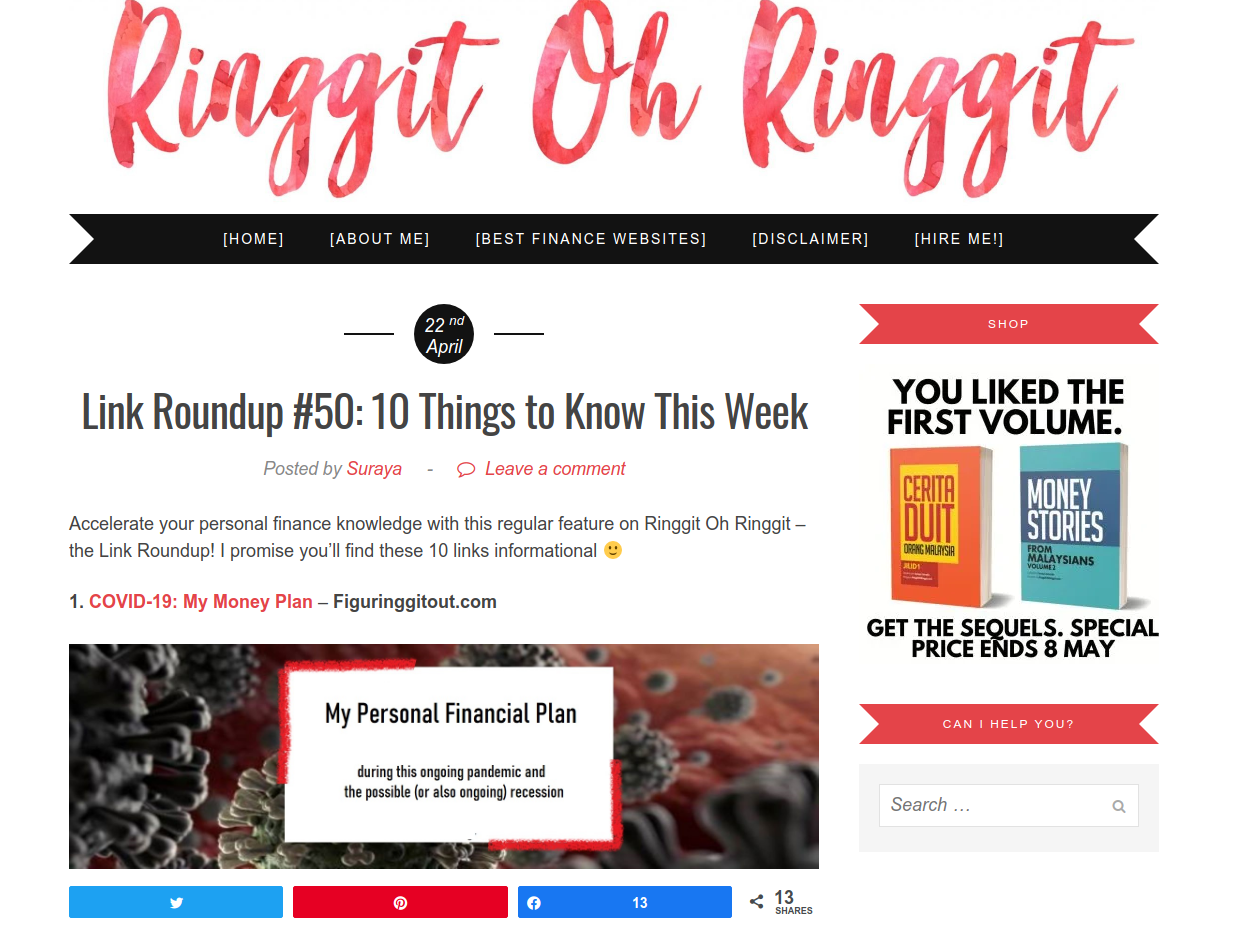
Moreover, link roundups have now moved to social media – thousands of Facebook groups publish the top weekly news, Twitter roundups are a common marketing technique for brands and businesses, even Slack communities maintain their own cadence.
Link roundups resemble press releases at a small scale – you run a story and promote it across media channels to attract media attention and generate some buzz.
To dive into this technique, check out Growth Everywhere’s link roundup guide.
3. Quuu Promote
I discovered Quuu Promote through Sujan Patel a while back and instantly loved the practicality of the service.
Quuu is a content promotion platform that allows you to share a couple of posts a month and distribute them across Quuu’s own audience.
You have to subscribe for a monthly plan or pay per promoted post (for 30 days) – but yields better results than most PPC campaigns. Here’s what my dashboard looks like:
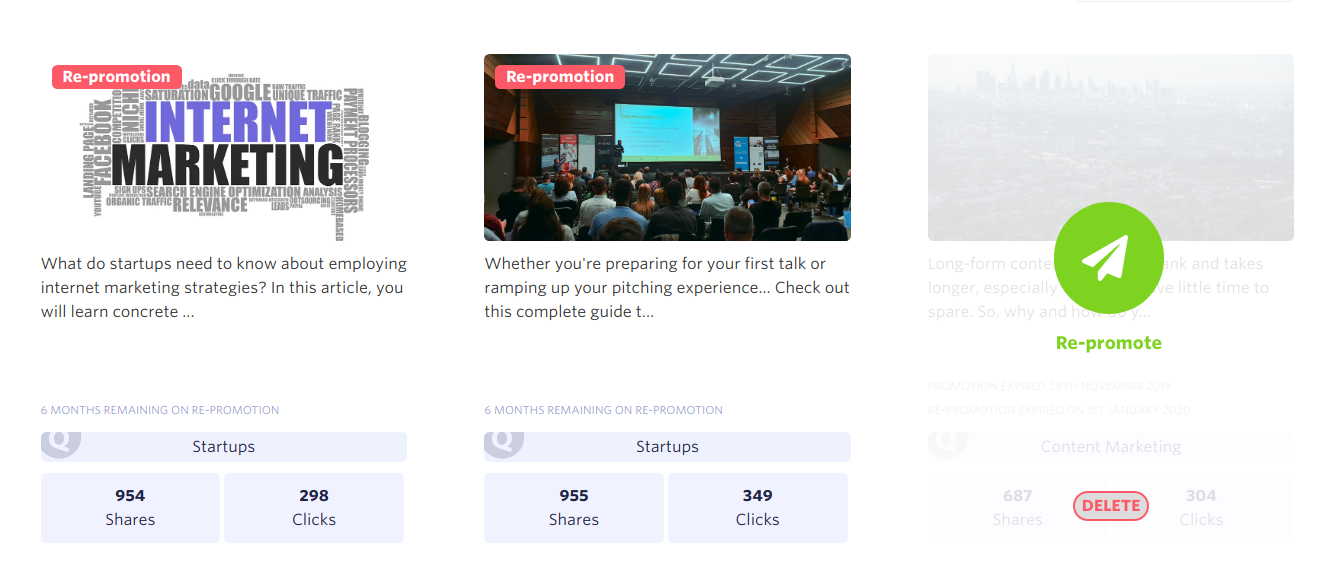
Generating nearly a thousand social shares and ~300 clicks per campaign is a great supplemental traffic source, not to mention social signals and brand benefits.
Quuu Promote supports automated shares via Twitter, Facebook, and LinkedIn. You start with the post you’re about to promote:
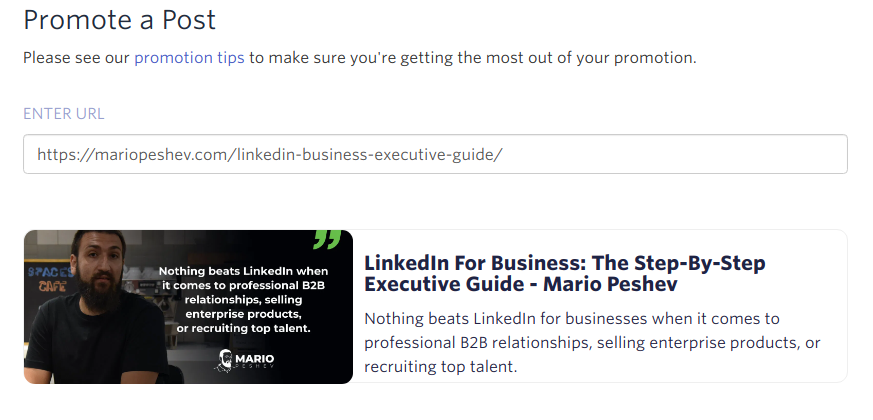
The meta title/description are fetched automatically, and then you can customize each message per social platform:
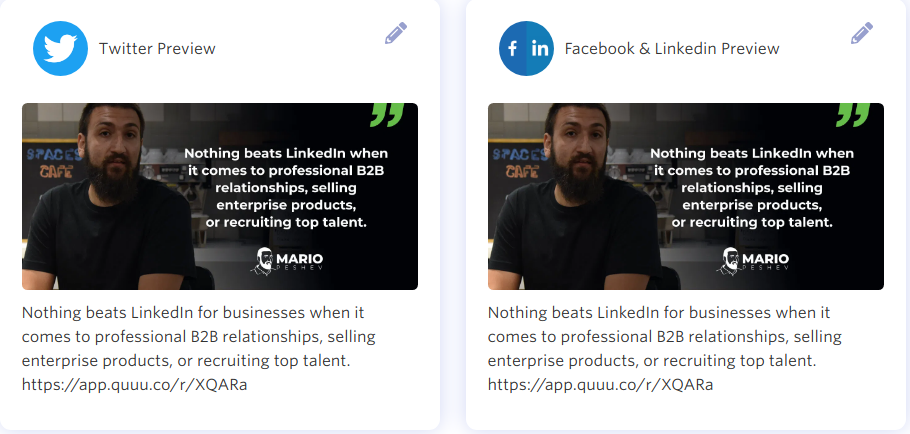
Each submission goes through a manual moderation queue. Once approved, you’ll get 30 days in regular post promotion across all networks.
4. Lumen5 Video Promotions
I’ve been advocating for content repurposing for years. But recycling existing content usually starts with video, exporting audio for podcasting, then slicing short clips for Instagram/LinkedIn, and using the transcript for blog posts or social statuses.
Lumen5 is my favorite tool that turns an article into a video – with automation so powerful you can literally run it on autopilot.
Here’s a sample guide I wrote on public speaking. While the long-form post was over 2,200 words long, I generated this video with Lumen5 and embedded it on top of the post:
So how exactly Lumen5 works?
It pulls the full post content and leverages AI to fetch powerful phrases and important details worthy of covering in each video slide.
You can submit your URL or paste your script in Lumen5:
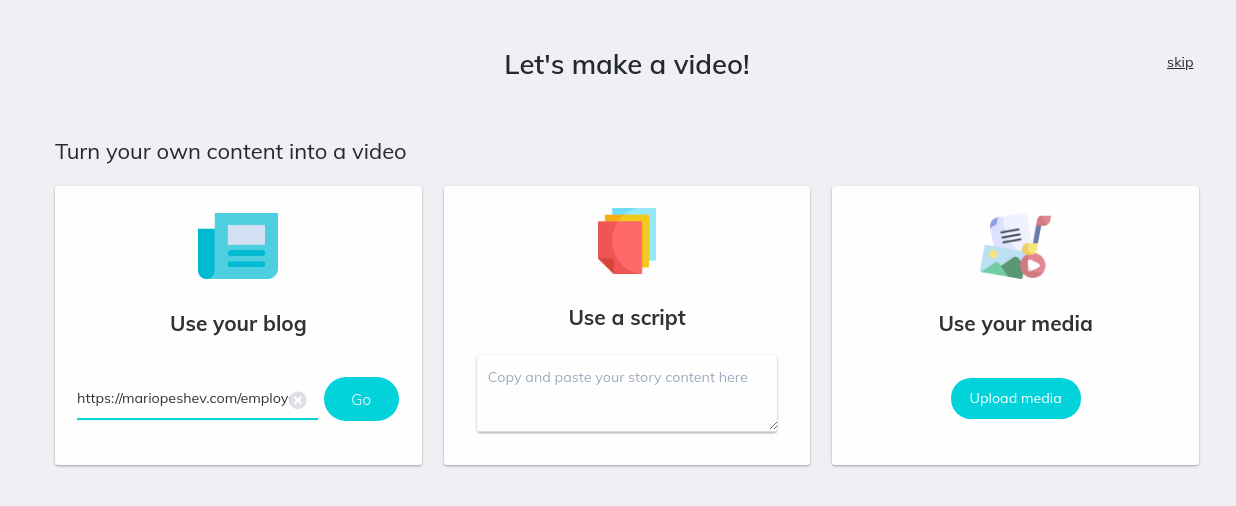
The platform is fully optimized for marketing, which is why it supports various video formats (resolutions) by default:
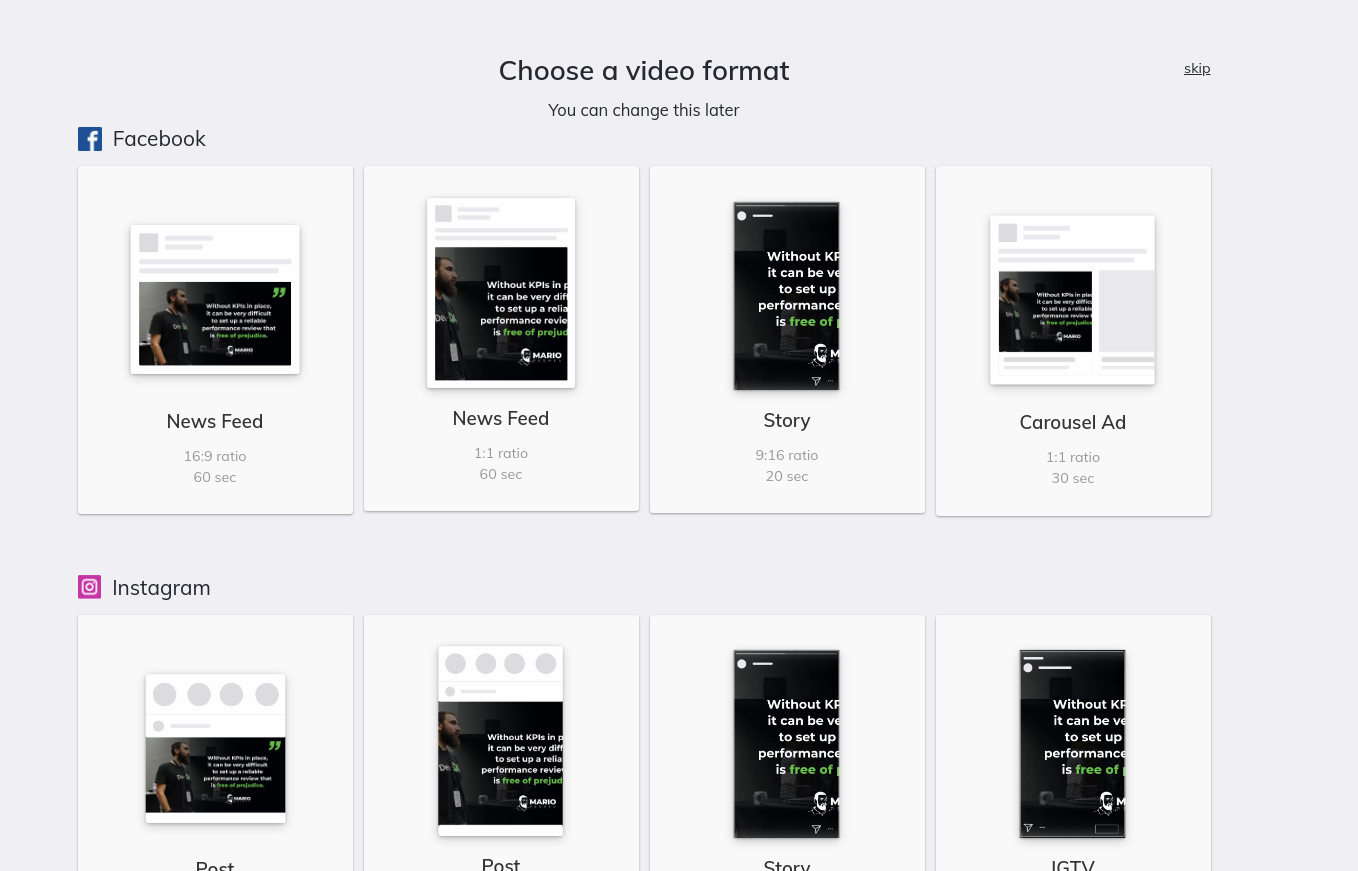
The video represents a number of slides (in a presentation format) with automatically generated text and images pulled from the original post. You’re in control of copy – pick snippets from the content body on the left to create a slide or edit an existing one to the right.
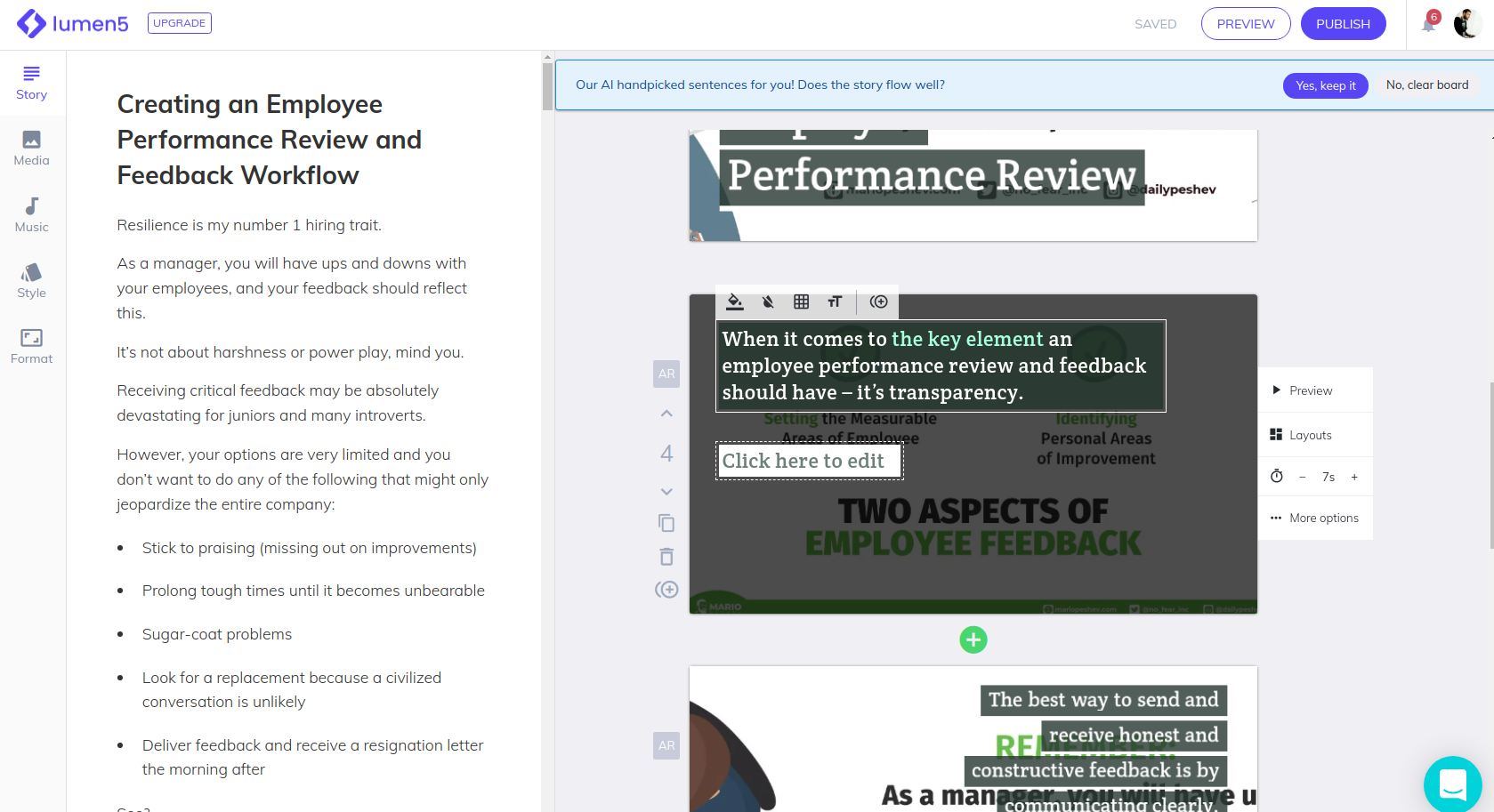
Once you are satisfied, pick a background tune and do some video fine tuning – and you’re ready to push your video to YouTube (or download for whatever media you need).
Here’s what makes Lumen5 so bloody brilliant:
- It’s freemium – it can’t get any better than that
- The AI is fairly smart and gets most of the work done anyway
- Lots of video format options you normally don’t get in video software
- Easily exportable for different networks
- Repurposes your content for video-friendly networks like YouTube
- Creates appealing videos for listicles
- Doesn’t require a ton of effort to record a video from scratch when you edit existing content
5. Twitter
Twitter is still a dominant social network with about 330 million monthly users. And while it may be falling behind other networks like Instagram or TikTok, it’s a lot more traffic-friendly when it comes to blog promotion.
It’s one of my most favorite social networks (side by side with LinkedIn) and forming up a percentage of my traffic comparable to Facebook:

There are different ways to approach content promotion through Twitter (depending on the size of your account). Here are several steps you can take short-term (after publishing a post) and long-term (as an evolution of your account):
- Share your story right after it goes live. That’s no different than other social networks out there.
- Post several other tweets with your article – two more throughout the day, a couple more over the week, and reoccurring after. Unlike LinkedIn or Instagram, reposting content on Twitter is expected – the lifetime of a tweet is short and you can target different audiences across time zones.
- Use hashtags effectively – they can be pretty handy if you know how to approach them.
- Use an evergreen recycling tool for regularly promoting your content (we’ll cover one further below).
- Twitter Cards – effectively using Twitter cards will boost your visibility and allow for embedding media in creative ways.
- Twitter Promote – like any other network, you can boost a single tweet or sign up for a monthly premium account to target a broader audience. Some communities are extremely active on Twitter (tech, VCs, SEO, journalists to name a few).
- Twitter chats – launch a Twitter chat on a certain topic to spark conversations with both followers and other Twitter users (since no sign up is required, nor approving friendships).
- Tag influencers and brands – prominent mentions are eye-catchy, and odds are, you’ll generate some buzz through retweets or follows once you tag influencers you’ve discussed or linked to in your post.
- Jump into threads – due to the nature of Twitter, you can interrupt any discussion going on in the public. As long as you interfere in a non-creepy way and regularly share actionable tips, you’ll soon become an influencer among your Twitter peeps.
- Moments – a Twitter version of stories that the brand launched.
- Live video – video streaming on Twitter has been available for years, but not natively through the client. The company owns Periscope and streaming there will notify your Twitter followers (especially if you want to promote your blog content with a Q&A or a webinar).
So here it is – Twitter is totally worth the time and even running it on autopilot can generate some views on a regular basis.
6. LinkedIn Slides
If you haven’t leveraged LinkedIn for organic reach over the past 2 years, you’ve been missing out – a lot.
Ever since Microsoft paid $26.2 billion for the platform back in 2016, their growth team has constantly pushed through with features, fine tuning the organic reach, and introducing certain features that other competitors haven’t fully adopted yet.
(One of the “secret” features are Newsletters, initially launched as Series, and I joined the beta pilot back in the day. Absolutely brilliant to build an audience, but not public yet.)
And the key feature I’m revealing right now is LinkedIn Slides.
SlideShare is also a member of LinkedIn’s family. And the level of organic reach when publishing slides is through the roof.
The only thing you have to do is upload a document through the main screen – select the “Document” format here:
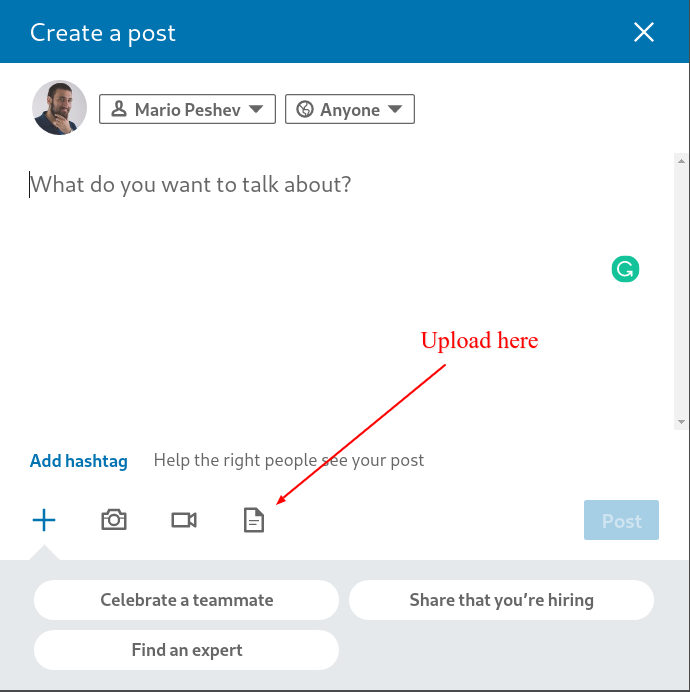
What content formats are suitable here?
- Short ebooks
- White papers
- Presentations
- Portrait-format presentations
- Infographics
We’re designing custom weekly slides for audience building, generating followers and subscribers to my email course:

Given the organic reach, as your post would gather enough attention, you can:
- Post a comment right under your post linking to a downloadable offer
- Form the presentation as a giveaway, asking people to comment to receive a free trial
- Invite them to a webinar
- Prepare a breakthrough (in a slides format) of your blog post and linking to it in the comments
While links in your slides are not clickable, use bit.ly or a similar service to prepare URLs within the slides that’s easy to type in.
7. Build a Simple Tool
OK – let’s go back to basics for a moment.
Promoting your blog means several things:
- Bringing fresh traffic
- Link building
- Recurring visitors accessing a page multiple times
- Generating a community/fanbase
What better way to accomplish that than building an actual tool?
Of course, building the next Microsoft Word or even Grammarly won’t be an easy feat. Neil Patel bought Ubersuggest in 2017 for $120,000 and invested millions to make it worthwhile. But that’s not what I’m talking about here.
Here are several ways you can leverage tool development with a modest (if any) financial investment.
- Quizzes – there are loads of quiz builders for WordPress. Building personality quizzes, business assessment surveys, or anything along those lines is an easy way to capture new emails, qualify leads, simplify your sales process.
- Calculators – I built Offer Calc back in 2012 to simplify web development offers for customers. From an estimation standpoint, it was a brilliant investment to simplify our sales process and land new customers. Calculators can be used in virtually any business – from restaurant appointments through purchasing furniture or mud for your garden.
- Integrated side projects – sites like CodeCanyon offer cheap tools for all sorts of industries, from loans through car rentals to currency exchange or weather forecast. Flippa is a great place to acquire ready-to-go sites and integrate them as a subdomain or a page of your own site. 1kprojects.com is another site that serves the same purpose – just figure out what your audience can repeatedly do and can be automated and push further.
Tools can absolutely change the name of the game. Headline analyzers, simple SEO tools, performance benchmarks, color scheme generators – a lot can go in. And quizzes? Sky is the limit.
8. Sharing Pods
Promoting your blog content requires traction – and organic engagement often requires some boost.
This led to the creation of the so-called “sharing pods” or “engagement pods”.
Pods are a small group of users who support each other’s content activities by sharing, linking, commenting, retweeting – you name it. Initial engagement is critical for social networks.
Video networks like YouTube also calibrate their algorithms depending on the traction over the first several hours. Unless you gather some attention in the first hour (up to the first day), your video won’t make it through the search algorithms later.
Let’s face it – if you stumble upon a post published 30min ago with a single like, are you going to engage yourself? Statistically speaking – odds are minimal.
But if this fresh post already generated 5 comments and 15 likes, you’re more likely to participate in a discussion (and read it more carefully). This is why social algorithms push this a lot higher than usual.
(Companies often coordinate these efforts internally across their marketing teams.)
On Facebook, pods usually represent closed groups with 15-20 other content creators sharing their content and sparking some engagement. Instagram works similarly when it comes to likes and comments – and even sharing posts across stories.
There are closed LinkedIn pods too (and some tools you can leverage).
And you can also sign up for automatic engagement pod services like:
Lempod is super handy in engaging with your LinkedIn audience.
First, you interact on autopilot with other members of “pods” you join – and grow your reach without lifting a finger.
Second, you can prepare engagement comments that you’d like to approach as comments, and follow-up with links or additional tips.
The service offers a Chrome extension that intercepts your post and enables you to submit your questions like this:
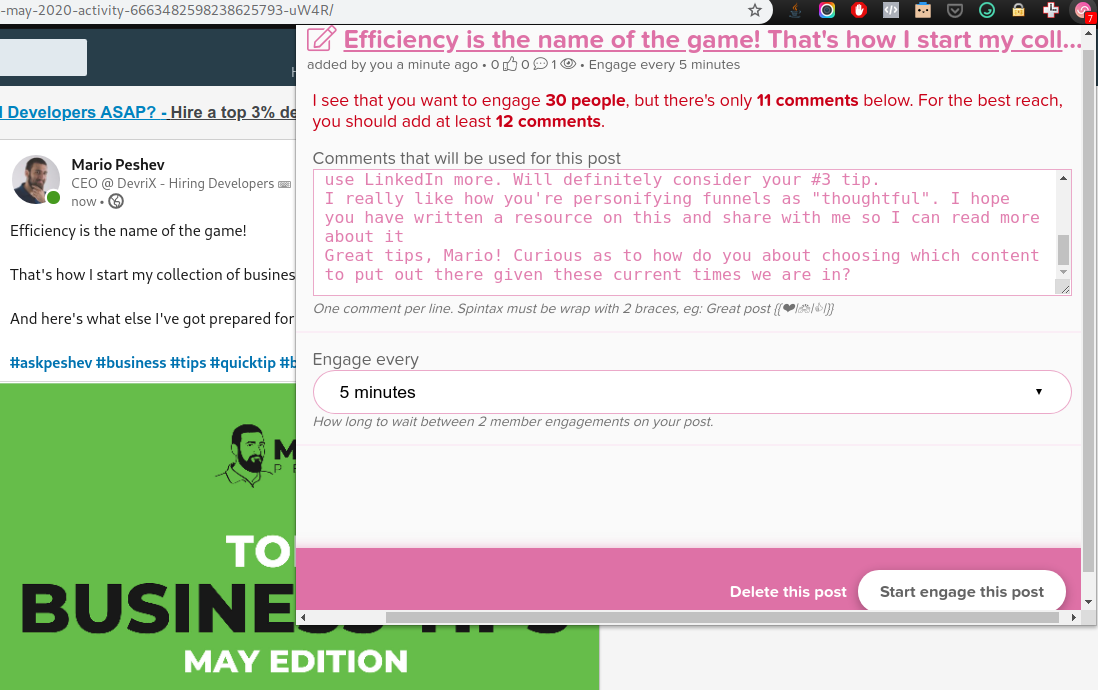
Sign up, join some relevant posts, and start engaging.
Each service introduces a new flavor suitable for promotion, but in a nutshell, connecting your posts to social media submissions and then expanding with pods can skyrocket your reach accordingly.
Promote Your Blog Consistently
Your promotion efforts shouldn’t be one-off – even though you can automate a good chunk of your work.
Target the right keywords, build high-quality content, leverage different channels, and steadily grow your traffic.
Google works like a reputation builder for your website. The better your content is, the more likely Google will put it in front of people when they search for something related.
Over time, if you consistently provide good content, Google will favor your website more and more. This is what we mean by growing your “organic reach” — basically, more people will find you naturally through Google searches without you having to pay for ads.
However, getting to that point is optional. When you’re just starting out or if you don’t have much content, you’re essentially a small fish in a big pond. This is why you need an initial push, like promoting your articles or using strategic keywords, to get Google’s attention in the first place.
With this first step to getting noticed, gaining traction, and improving your ranking is easier, no matter how good your content is.
What are the most effective promotion strategies you’ve utilized yourself?

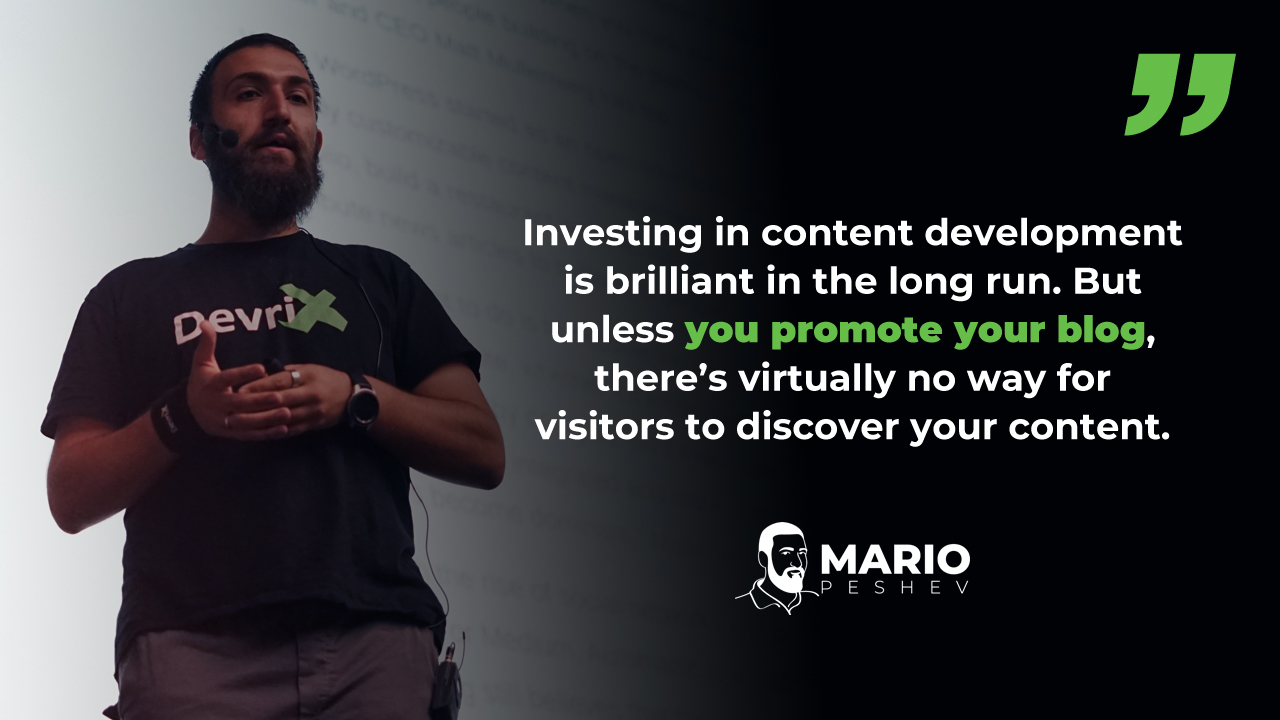



I really appreciate this post, I have wondered/worried about how to reconcile the little experience I have with the idea of teaching others, and this post (and in particular the movie reference) really has got me thinking in a different way than I have been.
Thanks again!
Hey Mario,
LinkedIn Slides is something I will definitely try. I am active on Quora and Twitter. Quuu looks promising as well. Thanks for the post man. You saved my time. If you have any webinar, try Webinarkhoj. I made this platform because I couldn’t find anything online regarding webinar promotion.
Happy to help – and your platform looks promising as well.